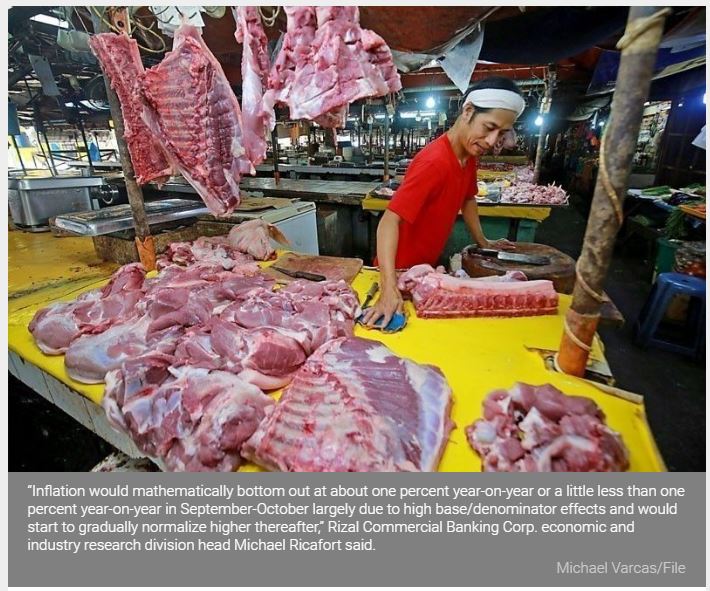Philippines: Inflation seen falling to 1% in September
MANILA, Philippines — Inflation may decline to as low as one percent in September from 1.7 percent in August with the higher oil prices due to the attacks in Saudi Arabia oil facilities as well as the impact of the African Swine Fever (ASF) outbreak seen to have minimal impact on consumer prices, according to economists.
“Inflation would mathematically bottom out at about one percent year-on-year or a little less than one percent year-on-year in September-October largely due to high base/denominator effects and would start to gradually normalize higher thereafter,” Rizal Commercial Banking Corp. economic and industry research division head Michael Ricafort said.
The last time inflation touched below one percent was at 0.9 percent in May 2016.
Inflation peaked at 6.7 percent in September and October last year and the consumer price index accelerated to 5.2 percent in 2018 from 2.9 percent in 2017, exceeding the two to four percent target set by the Bangko Sentral ng Pilipinas (BSP).
Ricafort said the ASF and the effects of the drone attacks on Saudi Arabia’s major oil production that resulted to slight uptick in global oil prices have minimal or negligible effects on overall inflation so far.
Ricafort said the full restoration of Saudi oil production much sooner than expected within September, the proposed higher tariffs or safeguard duties on imported rice during the harvest season and if there is an oversupply of rice as well as the government’s higher purchase price for palay would limit any further decline in overall inflation.
“Thus, all these factors would support some bottoming out in inflation,” Ricafort said.
The economist also cited the steady to slightly stronger peso exchange rate versus the dollar in September compared to August that could lead to some slight easing in import prices and inflation.
For his part, Security Bank chief economist Robert Dan Roces said inflation may drop to one percent for the month of September.
“Our estimate takes into account the latest pump price increase caused by tensions in the Middle East that caused global oil prices to rise. However, we do not see a repeat of the inflationary push similar to last year as production levels are slowly normalizing in Saudi Arabia. We also accounted for the fallout from the African swine fever that pushed prices for pork substitute goods to go up very slightly,” Roces said.
Roces also said inflation is seen falling below two percent until November due to favorable base effects and anticipated consumption factors in the coming months.
“With this, we have also adjusted our 2019 average inflation estimate to be at 2.5 percent, and remains consistent with the prevailing assessment of a benign inflation outlook over the policy horizon for the rest of year,” Roces said.
Source: https://www.philstar.com/business/2019/10/01/1956276/inflation-seen-falling-1-september#tchX8Eg3JPyE08Fx.99


 Thailand
Thailand




